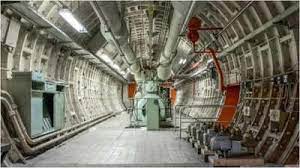Central London’s hidden underground tunnels, formerly utilized by spies who served as inspiration for James Bond, have been acquired by fund manager Angus Murray. His ambitious plan, with an estimated cost of £220 million ($269 million), is to convert these tunnels into a prominent tourist attraction, aiming to rival the iconic London Eye.

Angus Murray, an Australian-born former executive at asset manager Macquarie Group Ltd., has successfully secured a deal to purchase these tunnels from BT Group Plc, the former state telecom monopoly in the UK. The Kingsway Telephone Exchange, as it is officially known, occupies an extensive 8,000 square meters (86,111 square feet) beneath London’s Holborn district.
Murray envisions transforming the tunnels into a captivating tourist destination featuring immersive, blockbuster-inspired experiences. He intends to collaborate with renowned Hollywood studios, such as Warner Bros. Discovery (known for the Harry Potter series) and Amazon.com Inc. (owners of the James Bond rights), to create compelling attractions.
Simultaneously, Murray plans to preserve elements of the tunnels’ history, including what is believed to be the UK’s deepest bar, frequented by engineers and clerks who once worked underground. These workers played a vital role in maintaining the trans-Atlantic telecommunications line during the Cold War, used for diplomatic emergency calls.
Murray has drawn parallels between his vision for the tunnels and the iconic London Eye, expressing confidence that it could become an equally prominent tourist landmark.
Historical Significance: The tunnels, constructed in 1941 and 1942 as deep shelters during the London Blitz, were never used for their intended purpose due to the bombing’s decline. Instead, they became a covert base for the Inter-Services Research Bureau (ISRB), which later merged with MI6, the UK’s foreign intelligence service. Ian Fleming, the creator of James Bond, served as a liaison officer to the SOE (Special Operations Executive), a part of the ISRB, and drew inspiration from their espionage activities for his Bond novels.
The tunnels later functioned as a secure reserve war room, storing sensitive documents and hosting the secure hotline connecting US and Soviet presidents during the Cold War.
Development and Challenges: Angus Murray has outlined a four-year makeover plan for the tunnels, involving substantial financial investments. The initial phase, estimated at £40 million, aims to bring the site “up to construction” standards by the end of the following year. Subsequent phases, involving modern amenities, health and safety compliance, and immersive experiences, will cost approximately £100 million. The total investment required to prepare the space for the public by 2027 is estimated at £80 million.
Murray envisions partnerships with entertainment companies and technology manufacturers to create a state-of-the-art attraction. The tunnels offer space for a significant number of screens, potentially rivaling the famous advertising display at London’s Piccadilly Circus junction.
However, the project’s success depends on navigating the complexities of the UK’s planning system, as development decisions are controlled by local councils. The public has the opportunity to voice their opinions and vote on applications, which can pose challenges to ambitious commercial projects. Environmental and heritage concerns can lead to project rejections, as seen in the case of a proposed Disney-style theme park near London.
Despite these challenges, Angus Murray remains committed to his passion project, aiming to create a remarkable tourist attraction that showcases both history and immersive experiences deep beneath the streets of London.